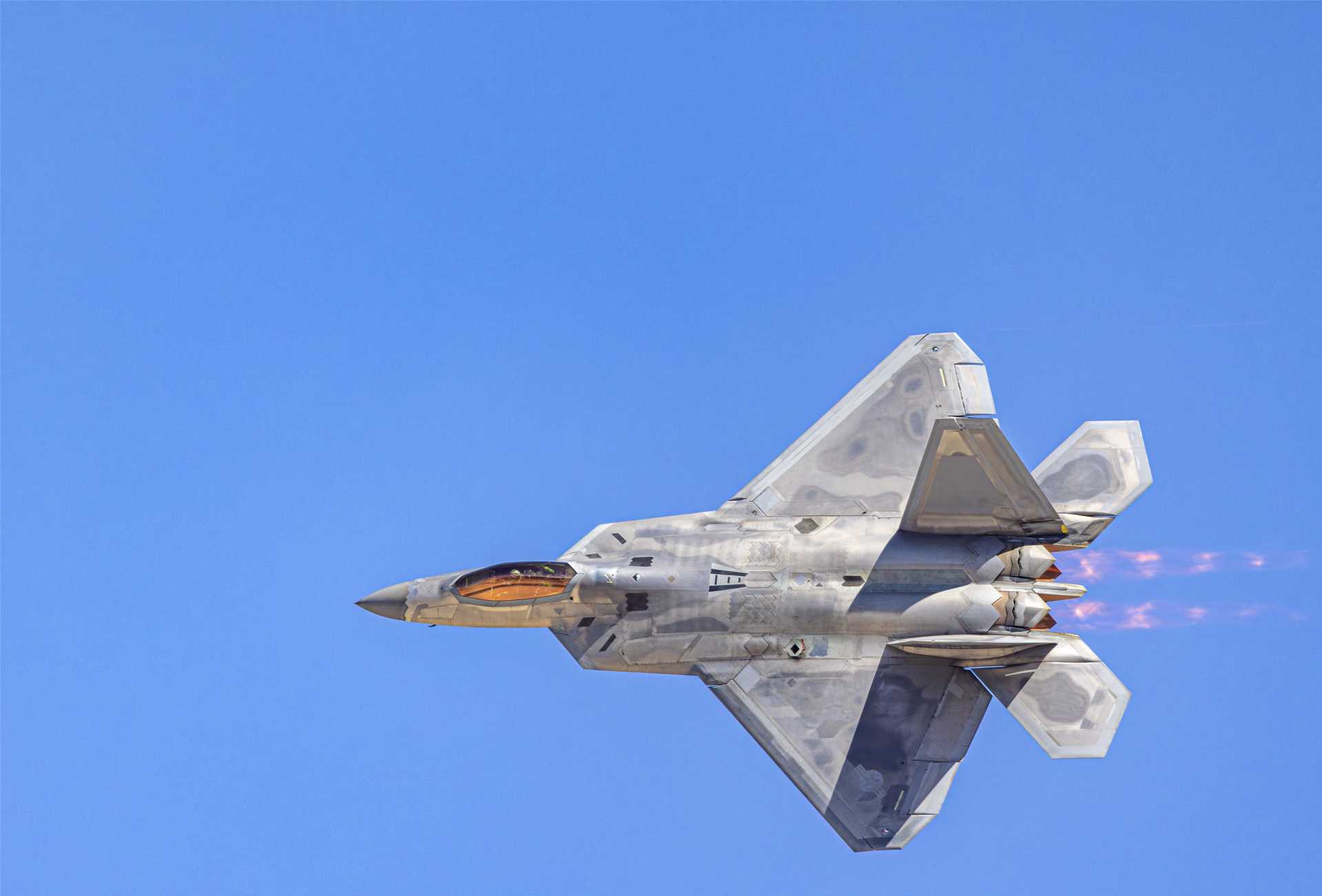Exclusive: U.S. F-22 Raptor Fighter Jet Upgraded with Infrared Sensors to Shoot Down Enemies Before Detection

{loadposition bannertop}
{loadposition sidebarpub}
Following the release of its Q1 2025 financial results on April 23, 2025, Lockheed Martin announced a pivotal enhancement to the F-22 Raptor stealth fighter jet program: the integration of a system of next-generation infrared sensors aimed at increasing the aircraft’s survivability and lethality. This strategic move reinforces Lockheed Martin’s commitment to maintaining U.S. air superiority and highlights the continued evolution of the F-22 as a dominant force in modern aerial warfare.Follow Army Recognition on Google News at this link
The U.S. Air Force’s F-22 Raptor receives a cutting-edge upgrade with the integration of next-generation infrared sensors, enabling the stealth fighter to detect and engage enemy aircraft before they can detect it. (Picture source: U.S. DoD)
The U.S. F-22 Raptor is widely regarded as the world’s most advanced air superiority stealth fighter jet and serves as a cornerstone of the U.S. Air Force’s tactical air power. Developed by Lockheed Martin under the Advanced Tactical Fighter (ATF) program, the F-22 entered service in 2005 with a unique combination of stealth, speed, agility, and situational awareness. It was the first operational aircraft to incorporate supercruise capability—sustained supersonic flight without afterburners—giving it unmatched reach and engagement speed. Its radar-absorbent materials, internal weapons bays, and sharply angled design ensure a minimal radar cross-section, enabling it to penetrate heavily defended airspace. The F-22 is primarily tasked with securing air dominance by neutralizing enemy fighters, protecting allied assets, and ensuring freedom of maneuver for follow-on forces. It also supports ground attack, intelligence gathering, and electronic warfare roles, making it a versatile and invaluable asset in the U.S. military’s arsenal.
At the center of this latest modernization is the Infrared Defensive System (IRDS), a sophisticated passive sensor suite designed to provide a decisive edge in contested environments. Unlike conventional radar systems, which emit signals that adversaries can detect, the IRDS detects and tracks threats using heat signatures, allowing the F-22 to operate under complete electromagnetic silence. This capability is particularly vital in missions where stealth and surprise are essential for mission success.
The IRDS provides the F-22 with 360-degree passive infrared surveillance, significantly improving situational awareness. In environments saturated with electronic warfare and where stealth aircraft are becoming more common, this system acts as a crucial second line of detection. It offers early warnings of threats such as enemy fighters and missile launches, even in cases where radar performance is limited by jamming or stealth countermeasures. This layered detection capability enhances both air-to-air and air-to-ground survivability.
One of the most strategically valuable aspects of the IRDS is its long-range targeting capability. By detecting thermal emissions, the system allows the F-22 to identify and engage enemy aircraft at great distances—often before the adversary is even aware of the Raptor’s presence. This ability aligns perfectly with the U.S. Air Force’s air superiority doctrine, built on the principles of “first look, first shot, first kill.” Coupled with long-range missiles such as the AIM-120 AMRAAM, the IRDS makes the Raptor a highly effective first-strike platform, particularly in anti-access/area denial zones.
In an era when nations like China and Russia are deploying their own fifth-generation fighters, the IRDS serves an equally critical role as a counter-stealth capability. Even the most advanced stealth aircraft emit some level of thermal signature due to engines and onboard electronics. The IRDS allows the F-22 Raptor to track and target these threats, countering the very technologies that are designed to challenge U.S. dominance.
Beyond its offensive benefits, IRDS enhances the F-22’s defensive posture by offering superior missile warning capabilities. It can detect incoming missile signatures and alert the pilot in real time, allowing for evasive maneuvers and the deployment of countermeasures such as flares or electronic jamming. This additional layer of defense is particularly useful during high-speed, high-G engagements where pilot workload is high and reaction time is critical. In some cases, the system can support semi-autonomous responses, providing pre-programmed tactical advice to navigate out of danger zones.
Furthermore, the IRDS is designed to integrate seamlessly with the F-22’s advanced sensor fusion architecture. This means data from the IRDS is combined with inputs from radar, electronic support measures, and other onboard systems to produce a unified and coherent operational picture. This fusion dramatically improves threat recognition and response times, enhancing the pilot’s ability to make rapid, informed decisions in dynamic combat scenarios. It also boosts the aircraft’s ability to coordinate with other assets across the battlespace, including legacy fighters, AWACS, and unmanned systems, thus reinforcing its role as a key node in networked warfare.
The F-22 Raptor, a technological marvel since its introduction, already excels through its combination of stealth, supercruise, agility, and unparalleled avionics. The integration of IRDS ensures it remains ahead of emerging threats and continues to define what it means to dominate the skies. Though this upgrade was not announced as part of a new contract, it is a major element of a broader modernization roadmap developed in partnership with the U.S. Air Force. This initiative includes enhancements across avionics, electronic warfare, and data networking, and is designed to maintain the aircraft’s tactical superiority well into the 2030s.
The addition of the Infrared Defensive System to the U.S. F-22 Raptor stealth fighter jet marks not just an upgrade, but a transformative leap in the F-22’s operational capacity. As global threats evolve and adversaries field more sophisticated air capabilities, the Raptor—with its new infrared eyes—remains a lethal and elusive apex predator in the skies. This modernization underscores why the F-22 continues to be considered the most capable air superiority fighter in the world, and why it will remain an integral part of the U.S. Air Force’s power projection for years to come.

{loadposition bannertop}
{loadposition sidebarpub}
Following the release of its Q1 2025 financial results on April 23, 2025, Lockheed Martin announced a pivotal enhancement to the F-22 Raptor stealth fighter jet program: the integration of a system of next-generation infrared sensors aimed at increasing the aircraft’s survivability and lethality. This strategic move reinforces Lockheed Martin’s commitment to maintaining U.S. air superiority and highlights the continued evolution of the F-22 as a dominant force in modern aerial warfare.
Follow Army Recognition on Google News at this link
The U.S. Air Force’s F-22 Raptor receives a cutting-edge upgrade with the integration of next-generation infrared sensors, enabling the stealth fighter to detect and engage enemy aircraft before they can detect it. (Picture source: U.S. DoD)
The U.S. F-22 Raptor is widely regarded as the world’s most advanced air superiority stealth fighter jet and serves as a cornerstone of the U.S. Air Force’s tactical air power. Developed by Lockheed Martin under the Advanced Tactical Fighter (ATF) program, the F-22 entered service in 2005 with a unique combination of stealth, speed, agility, and situational awareness. It was the first operational aircraft to incorporate supercruise capability—sustained supersonic flight without afterburners—giving it unmatched reach and engagement speed. Its radar-absorbent materials, internal weapons bays, and sharply angled design ensure a minimal radar cross-section, enabling it to penetrate heavily defended airspace. The F-22 is primarily tasked with securing air dominance by neutralizing enemy fighters, protecting allied assets, and ensuring freedom of maneuver for follow-on forces. It also supports ground attack, intelligence gathering, and electronic warfare roles, making it a versatile and invaluable asset in the U.S. military’s arsenal.
At the center of this latest modernization is the Infrared Defensive System (IRDS), a sophisticated passive sensor suite designed to provide a decisive edge in contested environments. Unlike conventional radar systems, which emit signals that adversaries can detect, the IRDS detects and tracks threats using heat signatures, allowing the F-22 to operate under complete electromagnetic silence. This capability is particularly vital in missions where stealth and surprise are essential for mission success.
The IRDS provides the F-22 with 360-degree passive infrared surveillance, significantly improving situational awareness. In environments saturated with electronic warfare and where stealth aircraft are becoming more common, this system acts as a crucial second line of detection. It offers early warnings of threats such as enemy fighters and missile launches, even in cases where radar performance is limited by jamming or stealth countermeasures. This layered detection capability enhances both air-to-air and air-to-ground survivability.
One of the most strategically valuable aspects of the IRDS is its long-range targeting capability. By detecting thermal emissions, the system allows the F-22 to identify and engage enemy aircraft at great distances—often before the adversary is even aware of the Raptor’s presence. This ability aligns perfectly with the U.S. Air Force’s air superiority doctrine, built on the principles of “first look, first shot, first kill.” Coupled with long-range missiles such as the AIM-120 AMRAAM, the IRDS makes the Raptor a highly effective first-strike platform, particularly in anti-access/area denial zones.
In an era when nations like China and Russia are deploying their own fifth-generation fighters, the IRDS serves an equally critical role as a counter-stealth capability. Even the most advanced stealth aircraft emit some level of thermal signature due to engines and onboard electronics. The IRDS allows the F-22 Raptor to track and target these threats, countering the very technologies that are designed to challenge U.S. dominance.
Beyond its offensive benefits, IRDS enhances the F-22’s defensive posture by offering superior missile warning capabilities. It can detect incoming missile signatures and alert the pilot in real time, allowing for evasive maneuvers and the deployment of countermeasures such as flares or electronic jamming. This additional layer of defense is particularly useful during high-speed, high-G engagements where pilot workload is high and reaction time is critical. In some cases, the system can support semi-autonomous responses, providing pre-programmed tactical advice to navigate out of danger zones.
Furthermore, the IRDS is designed to integrate seamlessly with the F-22’s advanced sensor fusion architecture. This means data from the IRDS is combined with inputs from radar, electronic support measures, and other onboard systems to produce a unified and coherent operational picture. This fusion dramatically improves threat recognition and response times, enhancing the pilot’s ability to make rapid, informed decisions in dynamic combat scenarios. It also boosts the aircraft’s ability to coordinate with other assets across the battlespace, including legacy fighters, AWACS, and unmanned systems, thus reinforcing its role as a key node in networked warfare.
The F-22 Raptor, a technological marvel since its introduction, already excels through its combination of stealth, supercruise, agility, and unparalleled avionics. The integration of IRDS ensures it remains ahead of emerging threats and continues to define what it means to dominate the skies. Though this upgrade was not announced as part of a new contract, it is a major element of a broader modernization roadmap developed in partnership with the U.S. Air Force. This initiative includes enhancements across avionics, electronic warfare, and data networking, and is designed to maintain the aircraft’s tactical superiority well into the 2030s.
The addition of the Infrared Defensive System to the U.S. F-22 Raptor stealth fighter jet marks not just an upgrade, but a transformative leap in the F-22’s operational capacity. As global threats evolve and adversaries field more sophisticated air capabilities, the Raptor—with its new infrared eyes—remains a lethal and elusive apex predator in the skies. This modernization underscores why the F-22 continues to be considered the most capable air superiority fighter in the world, and why it will remain an integral part of the U.S. Air Force’s power projection for years to come.





